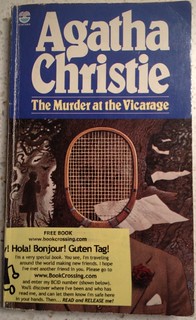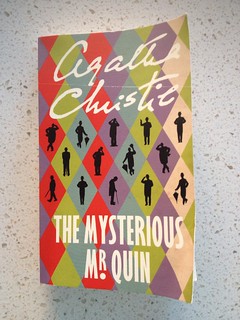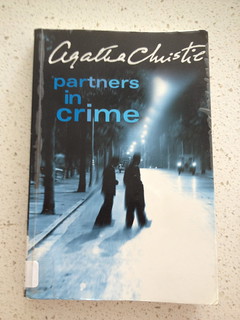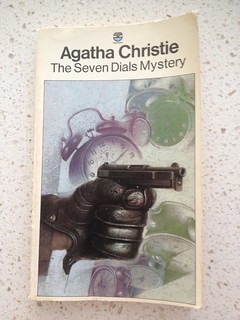 KATHRYN:
KATHRYN:So, first, I just need to get it off my chest that one of my first shocks in this book is that Lettice Protheroe’s name is Lettice, and not Lettuce. I have read and seen this book several times before and to me she is always *Lettuce*. Having read the book before also meant that the murderer was not a surprise, nor were any of the other mysteries that were uncovered during the story. And this meant I could really focus on how Miss Marple is portrayed in her first full length book*. Miss Marple is certainly not the star of ‘The Murder at the Vicarage’, which is narrated, perhaps appropriately, by the Vicar (Mr Clements). She is introduced of one of several gossipy old ladies at a morning tea held by the Vicar’s wife, the inappropriate Griselda, and both the Vicar and Griselda have relatively low opinions of these ‘old cats’, as they are referred to often. Actually I suspect that Christie might have been writing this book so that Miss Marple herself was a surprise - it only becomes apparent that Miss Marple’s ‘gossip’ has rather more substance than Mrs Price Ridley’s or Miss Hartnell’s as the story develops. I wonder if anyone realised how iconic she would become.
The narration by the Vicar is quite reminiscent to that of Hastings narration for Poirot - or even of Dr. James Sheppard (the murderer) in ‘The Murder of Roger Ackeroyd’, and it seems to be a common technique for Christie to use in her proper ‘whodunnits’ (as compared to the slightly whacky spy stuff we have also seen to-date). I guess it’s a good technique because the narrator can be led on a few wild goose chases and suitably surprised when the murderer is revealed. The narrator can also be unreliable - quite spectacularly so in the case of Dr Sheppard - and even I think a little bit in the case of the Vicar, who I think doesn’t like to admit just how much he loves his inappropriate wife.
Miss Marple doesn’t have a constant companion, so I will be looking with interest to see how the narration is undertaken in future Marple books (because for the life of me I cannot remember!!) I was surprised that Miss Marple’s nephew, the writer Raymond West, was present in this, her first book. I had imagined he was an addition of later stories, and he was a good deal more fashionable and callow than I remember him, though again perhaps that again is coloured by the Vicar’s narration (and potential jealousy of the attraction of Griselda to Raymond!)
And just a word on the murderer(s). Is it my imagination, but have a number of Christie’s murderers to-date been rather charming men who turn out to be far more ruthless than first seems? Perhaps I should start a tally. I also wonder how scandalous it was that Lawrence Redding and Mrs Protheroe were having an extramarital affair in 1930. It’s not so shocking now, but there are a number of hints that several ladies could have been gallivanting around with Lawrence, which surely was a bit risque?
All in all, I really enjoyed this reread of ‘The Murder at the Vicarage’. It’s full of excellent misdirection, character studies and village gossip, which is really what I think of when I think of a Christie whodunnit.
*Apparently Miss Marple’s first appearance was in a short story ‘The Tuesday Night Club’, written in 1926. However the collection it was published in - ‘The Thirteen Problems’ - was not published until 1932, so we have a few books to go until we get to it...
TANSY:
I really enjoyed this! I hadn’t read it before so I was quite surprised at how unappealing Miss Marple was early on - she seemed really gossipy and horrible and gradually became more and more likeable as the story went on. By the end she felt more like the Miss Marple I know from later books - gentler and more knowing and subtle. Possibly this is a case of the character simply growing as the author wrote her, but I like to think it’s because, as you say, the vicar’s perspective also shifts throughout the novel.
The story felt so similar to Roger Ackroyd, largely because of the way the narrator was set up, that I was almost convinced that our lovely vicar had in fact done the murder himself, except that I was fairly sure if she had pulled that trick again I would have heard about it. The Len-Griselda relationship was fascinating, and itself something of a mystery to be unravelled. I was very happy that there was nothing at all to be suspicious about either of them, as Griselda in particular was such a funny character. How terribly modern of her to commit to being an appalling housewife, and to cleave to her bad maid in order to keep her!
Len reluctantly convincing Mary to stay was one of my favourite scenes in the book, but it was full of all kinds of domestic gems.
The plot of this one is fascinating too - it’s another tricky one, though not as famous I guess as ‘they all did it’ or ‘the narrator did it’ to be talked about more? But I like that once again Christie is providing meta commentary on the genre of the murder mystery, in this case noting that realistically, the most obvious suspect is usually the murderer. And of course this has the whole ‘if a murderer was clever they would act suspiciously because acting innocent is a dead giveaway’ trick to it, which is nicely done.
Raymond was quite appalling! I’ve never seen him on screen before, only remember Miss Marple talking about him, so I was quite amused by what a vulgar intellectual snob he seemed to be. Again, though, the vicar’s perspective colours everything.
All in all, this is a lovely launch for Miss Marple and I like how much we get to see her working out how exactly a little old lady should go about being a detective, from first principles. Can you believe it was another twelve years before she appeared in another novel? Thank goodness for short stories!
Coming up:
1931: The Sittaford Mystery (also Murder at Hazelmoor ), Emily Trefusis, Inspector Narracott
1932: Peril at End House, Hercule Poirot, Arthur Hastings, Chief Inspector Japp
1932: The Thirteen Problems, Miss Marple Shorts
1933: Lord Edgware Dies (also Thirteen at Dinner ), Hercule Poirot, Arthur Hastings, Chief Inspector Japp


